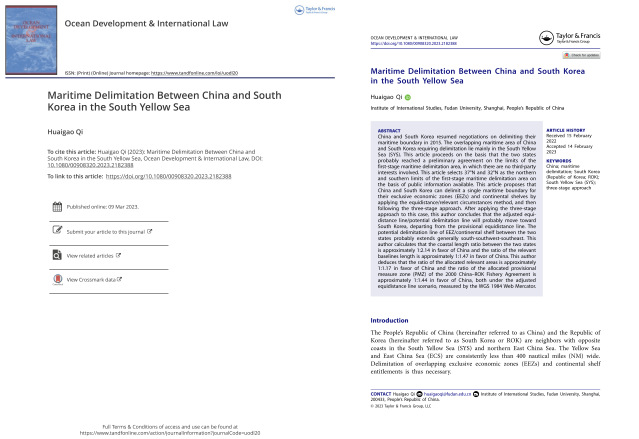Huaigao Qi: Maritime Delimitation Between China and South Korea in the South Yellow Sea, Ocean Development & International Law, Vol. 54, No. 1 (2023), pp. 26-62.
To link to this article: https://doi.org/10.1080/00908320.2023.2182388

Abstract: China and South Korea resumed negotiations on delimiting their maritime boundary in 2015. The overlapping maritime area of China and South Korea requiring delimitation lie mainly in the South Yellow Sea (SYS). This article proceeds on the basis that the two states probably reached a preliminary agreement on the limits of the first-stage maritime delimitation area, in which there are no third-party interests involved. This article selects 37°N and 32°N as the northern and southern limits of the first-stage maritime delimitation area on the basis of public information available. This article proposes that China and South Korea can delimit a single maritime boundary for their exclusive economic zones (EEZs) and continental shelves by applying the equidistance/relevant circumstances method, and then following the three-stage approach. After applying the three-stage approach to this case, this author concludes that the adjusted equidistance line/potential delimitation line will probably move toward South Korea, departing from the provisional equidistance line. The potential delimitation line of EEZ/continental shelf between the two states probably extends generally south-southwest-southeast. This author calculates that the coastal length ratio between the two states is approximately 1:2.14 in favor of China and the ratio of the relevant baselines length is approximately 1:1.47 in favor of China. This author deduces that the ratio of the allocated relevant areas is approximately 1:1.17 in favor of China and the ratio of the allocated provisional measure zone (PMZ) of the 2000 China–ROK Fishery Agreement is approximately 1:1.44 in favor of China, both under the adjusted equidistance line scenario, measured by the WGS 1984 Web Mercator.
Key words: China; maritime delimitation; South Korea (Republic of Korea; ROK); South Yellow Sea (SYS); three-stage approach
Acknowledgements: The views expressed herein are solely those of the author and do not necessarily reflect the views of any institution or government. The author expresses thanks to two anonymous reviewers of Ocean Development & International Law, Professor Karen N. Scott of the School of Law at the University of Canterbury, Assistant Professor Qin Zhu of the Institute of International Studies at Fudan University (IIS Fudan), Associate Professor Wei Huang of the China Institute of Boundary and Ocean Affairs at Wuhan University (CIBOS WHU), and Associate Professor Wenxian Qiu of Guanghua Law School at Zhejiang University, for their helpful comments. Thanks to engineer Dandan Miao of the Digital Engineering Department at CIBOS WHU for drawing the maps (Figure 1, Figure 2, Figure 3, Figure 4, Figure 6, Figure 7, Figure 8, Figure 9, and Figure 10), and thanks to PhD candidate Yixuan Wei of School of International Relations and Public Affairs at Fudan University (SIRPA Fudan) for collecting research materials.






